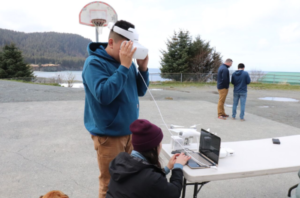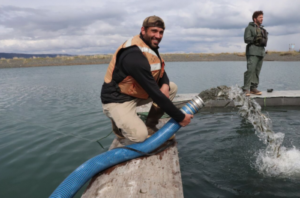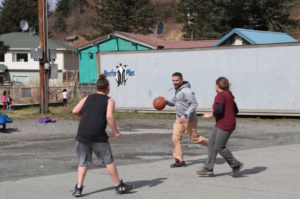Each summer, Alaska’s mature salmon turn on their internal homing devices and return to their origin waters to finish out their life journey. But as the number of reds returning to the waters near the Alaska Native village of Nanwalek continues to ebb, it’s also drawn the return of community collaborators: APU’s Fisheries, Aquatic Science, and Technology (FAST) Lab and the Alaska Department of Fish and Game (ADF&G).
For the second year, undergrad and graduate students at Alaska Pacific University have accompanied Dr. Brad Harris, FAST Lab Director, with fieldwork in and around Homer, Alaska.
While last year, the field work was completed by students in the Ichthyology class, this year’s cohort was comprised of students enrolled in Fisheries Ecology. Students helped ADF&G staff with Pacific razor clam surveys, building salmon weirs on various rivers, and restocking the Nick Dudiak lagoon on the Homer spit with juvenile salmon. The class also revisited the Alaskan Native village of Nanwalek, located across Kachemak Bay near Port Graham.
During their visit last year, students tested numerous theories — ranging from water quality and environmental samples to using a drone and mapping the watershed — as to why the salmon returns are declining. And during each test, they got the community involved in the efforts.
“The point of us being there is for everybody to learn something,” Dr. Brad Harris said of the 2017 iteration of the class.
Graduate student Karli Tyance-Hassell presented the community with a mosaicked map of more than 5,000 drone images from the prior year’s visit of Nanwalek’s nearby lake system, which hosts a sockeye salmon run.
“The map’s resolution is truly amazing because if you zoom into Second Lake, where the sockeye primarily spawn, you can actually see the depressions in the gravel, which are salmon nests, along the lakeshore from the previous spawning season,” Tyrance-Hassell said.
Tyance-Hassell’s thesis for her master’s focuses on mapping the area and determining potential sources of the decline, as well as exploring traditional ecological knowledge in salmon fishery monitoring and management. She hopes the map will act as a baseline for the system, a tool that can be used to see any changes — erosion, sediment changes, spatial usage of spawning habitat — over time, so the community can make effective fishery management decisions for conservation purposes.
“We flew the drone again this May to further build upon the mosaic,” Tyance-Hassell said. “We also hope to fly it again during the spawning season as you would be able to see sockeye spawning in real time and get an idea of the spatial distribution.”
While in Nanwalek, students hosted outreach programs centering on STEM and fisheries for some of the local children, leading activities spanning from a fish form and function station, to drones and mapping station, and an eDNA station.
APU president Dr. Bob Onders flew to Nanwalek during the class’s visit to meet community members, speak with leaders about the new partnership between APU and Alaska Native Tribal Health Consortium, and even challenged the community to a basketball game against himself and the APU students.
When not actively involved in fieldwork, the class also listened to several lectures given by local fisheries biologists and researchers, including Ken Goldman, Ted Otis, Mike Booz, Coowe Walker, Maya Groner, and the FAST Lab’s Nathan Wolf, Suresh Sethi, and Bobby Murphy. The topics ranged from applications of social science in fishery systems to managing marine diseases in fished populations.
“The weather was a bit cooler than last year,” said graduate student Kelsey Bockelman, who was also enrolled in last year’s Ichthyology course. “But the scenery was no less beautiful or the work done any less interesting.”



